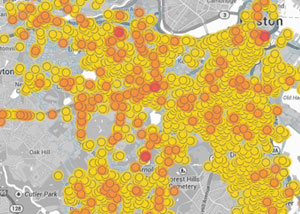Secretary of Energy Ernest Moniz announced steps to cut methane emissions from natural gas, including desperately needed upgrades to pipelines leaking across the US.
Actions include establishing efficiency standards for natural gas compressors and incentives to modernize natural gas distribution networks.
Here’s what the Department of Energy (DOE) is doing to stop leaks:
- Begin the process of establishing energy efficiency standards for new natural gas compressor units, estimated to consume over 7% of natural gas in the US;
- Evaluate and establish a manufacturing R&D program to improve natural gas system efficiency and reduce leaks;
- Accelerate investments in infrastructure modernization and repairs to natural gas distribution networks in partnership with the National Association of State Regulatory Utility Commissioners.
Google Street View
Even more common than flaring from fracking, methane is leaking from pipelines across the country. To illuminate this, Google and Environmental Defense Fund (EDF) are creating online maps that show these leaks, starting with Boston, Indianapolis and Staten Island. Google Street View cars are outfitted with new sensing and analytical technologies that can measure these and other hard-to-detect environmental contaminants.
Developed with Colorado State University researchers, the system can measure how much gas is escaping from leaks of all sizes.
While utilities routinely monitor pipelines as required by state and federal regulations, until now it’s been hard to know how much gas (and thus methane) is escaping from any one a leak. They fix the big ones, but that leaves vast numbers of others, says EDF.
Lots of leaks in Boston, where there are lots of old pipes:

Few in Indianapolis, where pipes are new:

EPA is also being criticized for not addressing pipeline leaks – from its own Inspector General, which finds that over $192 million worth of natural gas is lost to leaks each year. While EPA’s Natural Gas STAR program encourages utilities and gas companies to voluntarily cut methane emissions voluntarily, it isn’t required, they say. And the Department of Transportation’s Pipeline and Hazardous Materials Safety Administration – which carries out inspections – is chronically under-funded.
The feds are also failing to inspect oil and gas drilling sites, where spills are a common occurrence. Last year, spills were up 17% – with a minimum of 7,662 spills or leaks in the 15 most active states, according to EnergyWire. That’s more than 20 spills a day! Each may be small, but cumulatively they total about 26 million gallons of oil, and fracturing fluid and wastewater. In Colorado, where there are 52,000 active wells, there are about two spills a day, and no one tells residents," reports Denver Post.
Here’s a fact sheet on DOE’s efforts:

